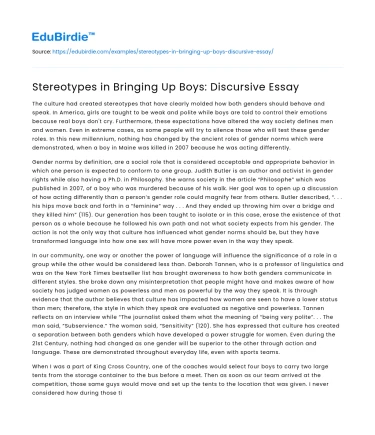The culture had created stereotypes that have clearly molded how both genders should behave and speak. In America, girls are taught to be weak and polite while boys are told to control their emotions because real boys don't cry. Furthermore, these expectations have altered the way society defines men and women. Even in extreme cases, as some people will try to silence those who will test these gender roles. In this new millennium, nothing has changed by the ancient roles of gender norms which were demonstrated, when a boy in Maine was killed in 2007 because he was acting differently.
Gender norms by definition, are a social role that is considered acceptable and appropriate behavior in which one person is expected to conform to one group. Judith Butler is an author and activist in gender rights while also having a Ph.D. in Philosophy. She warns society in the article “Philosophe” which was published in 2007, of a boy who was murdered because of his walk. Her goal was to open up a discussion of how acting differently than a person’s gender role could magnify fear from others. Butler described, “. . . his hips move back and forth in a “feminine” way . . . And they ended up throwing him over a bridge and they killed him” (115). Our generation has been taught to isolate or in this case, erase the existence of that person as a whole because he followed his own path and not what society expects from his gender. The action is not the only way that culture has influenced what gender norms should be, but they have transformed language into how one sex will have more power even in the way they speak.
Save your time!
We can take care of your essay
- Proper editing and formatting
- Free revision, title page, and bibliography
- Flexible prices and money-back guarantee
In our community, one way or another the power of language will influence the significance of a role in a group while the other would be considered less than. Deborah Tannen, who is a professor of linguistics and was on the New York Times bestseller list has brought awareness to how both genders communicate in different styles. She broke down any misinterpretation that people might have and makes aware of how society has judged women as powerless and men as powerful by the way they speak. It is through evidence that the author believes that culture has impacted how women are seen to have a lower status than men; therefore, the style in which they speak are evaluated as negative and powerless. Tannen reflects on an interview while “The journalist asked them what the meaning of “being very polite”. . . The man said, “Subservience.” The woman said, “Sensitivity” (120). She has expressed that culture has created a separation between both genders which have developed a power struggle for women. Even during the 21st Century, nothing had changed as one gender will be superior to the other through action and language. These are demonstrated throughout everyday life, even with sports teams.
When I was a part of King Cross Country, one of the coaches would select four boys to carry two large tents from the storage container to the bus before a meet. Then as soon as our team arrived at the competition, those same guys would move and set up the tents to the location that was given. I never considered how during those times, my coach would never ask girls to move the tents because the culture has influenced what characteristics each sex should do or in this case carry. In the manner that, culture had drilled into society, that girls' muscles in their body are frail, therefore weak, and are told to let the boys carry heavy objects because they are stronger. Just like my coaches, society has further segregated boys and girls, especially in their activities.
Everyone is born with an open heart and the desire to be accepted by others. However, as they grow older and will be influenced by society, pop culture and family norms. They slowly adopt the gender roles that society sets before them. Gender roles and expectations will always be a part of our culture. It is stated best from a traditional nursery rhyme, “What are little boys made of? What are little boys made of? Snips and snails And puppy-dogs tails. That's what little boys are made of? What are little girls made of? What are little girls made of? Sugar and spice And everything nice, That's what little girls are made of”.






 Stuck on your essay?
Stuck on your essay?

